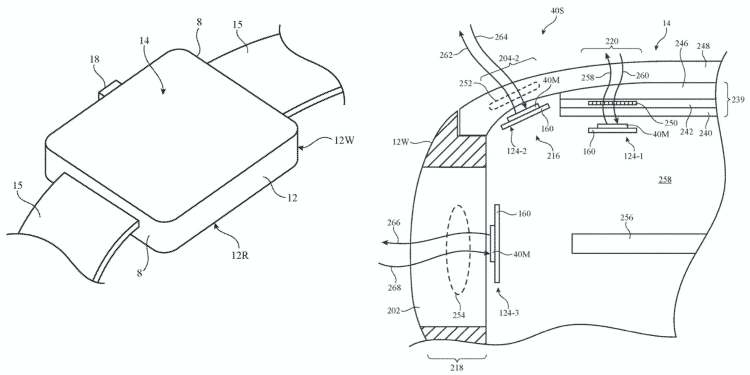Smartphone makers have struggled over the past year to squeeze millimeter wave 5G antennas into devices with smaller than 6-inch screens and 8mm thick bodies. But Apple is already working on future versions of the Apple Watch with millimeter wave hardware, which it suggests will be capable of supporting either 5G cellular networks or a fast variant of Wi-Fi known as 802.11ad.
Apple’s plans for millimeter wave Watches were disclosed in a patent application that was published today (via Patently Apple) after a filing early last year, indicating that the company has been directly confronting the miniaturization and related engineering challenges associated with the fastest version of the 5G standard. While the company could have easily added Chinese, European, or South Korean network-compatible 5G support using non-millimeter wave antennas similar to 4G, it’s instead looking to support both millimeter wave and prior radio frequencies in the Apple Watch, despite its small size.
In short, the patent contemplates that separate millimeter wave and non-millimeter wave antennas could be mounted inside the Watch’s side walls and/or beneath the screen. Using a combination of directional and beam-forming technologies, as well as multiple antennas as needed, the radio signals would point upward and outward rather than toward the user’s wrist, enabling the Watch to achieve much faster data transmissions than before.
Interestingly, Apple isn’t limiting the millimeter wave hardware’s use to 5G. The patent application specifically contemplates support for the millimeter wave-based 802.11ad standard, which is currently being used by other companies to deliver particularly high-bandwidth data to VR headsets, as well as other communication protocols such as future versions of Bluetooth.
June 5th: The AI Audit in NYC
Join us next week in NYC to engage with top executive leaders, delving into strategies for auditing AI models to ensure fairness, optimal performance, and ethical compliance across diverse organizations. Secure your attendance for this exclusive invite-only event.
While this mention could be taken as just broadly exploring multiple types of potential applications for the new hardware, it hints at something Apple executives have obliquely teased before — the prospect that the Apple Watch might one day serve as a full iPhone replacement, perhaps wirelessly paired with AR glasses. A high-bandwidth connection between the glasses and a device would be necessary to quickly transmit high-resolution stereoscopic imagery generated by a Watch or iPhone for smooth, nausea-free viewing.
Additionally, the same antenna hardware could be used for radar, as Apple suggests that the Watch could use signal reflections to determine its range from external objects — the user, other people, animals, furniture, walls, and obstacles in the vicinity. Prior to their miniaturization in smartphones, millimeter wave antennas were used for much larger radar systems, making this implementation akin to smartphone “flashlights” powered by LED rear camera flashes.
As always, patent applications don’t guarantee the introduction of a new product at any point, let alone in the immediate future, but the fact that Apple has been actively working on these technologies for the Watch should reassure anyone convinced that it would remain 4G-only for the foreseeable future. Apple is expected to debut its first 5G phones next year, and recently acquired Intel’s smartphone modem development division to create its own 5G modems.

